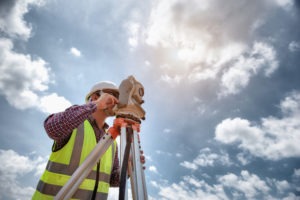
You may have heard of land surveys or even received one for your property before. But what exactly does a land survey provide? And how can it benefit residential and commercial property owners?
Land surveying is an essential service, and a wide variety of professionals utilize the finalized reports. We have compiled everything you should know about land surveying below. Let’s explore.
What Is a Land Survey?
A land survey is a diagram of your property and all its boundaries. A land survey may also feature other elements depending on the type of survey you request. For example, a boundary survey shows property lines and structural improvements on a plot of land, while topographic surveys display contour lines and elevation changes.
A finalized land survey will also include a written list of observations from the surveyor and a legal description. You can use this information when purchasing, selling, or adding new construction to your plot of land.
When producing a land survey, professionals will reference your lot’s deed to determine its dimensions. However, in many circumstances, deeds can be outdated or incorrect. Therefore, a professional land surveyor will perform fieldwork on the property. They use the collected measurements and data to establish the precise boundaries for your plat.
What Are the Different Types of Land Surveys?
Land surveying is not a cookie-cutter solution. A professional can provide many different types of land surveys, and each includes unique information about a parcel of land.
Boundary Surveys
A boundary survey is the most basic type of land survey. It establishes a property’s boundary lines and ensures the land’s legal description matches. A professional boundary survey will also include the locations of any structural improvements on the property, including sheds, pools, and garages.
Land Title Surveys
ALTA, which stands for the American Land Title Association, surveys are a specific type of boundary survey. They are intended explicitly for title companies or lenders of mortgage or title insurance.
ALTA outlines specific requirements that the survey must incorporate. These include:
- Underground utility locations
- Ancillary building locations
- Easement identifications
- Boundary lines
- Building and underground structure square footage
Anytime your property changes ownership or you make significant changes to your plot, you may need an updated ALTA survey.
Topographic Surveys
A topographic survey displays elevation changes, terrain, and landforms that a traditional map or survey does not include. A topographic survey will illustrate a property’s elevation through contour lines. It also shows the locations of artificial and natural utilities and structures.
Topographic surveys play a critical role for developers. They must be aware of how the property’s terrain can impact their new designs. The more information an architect or engineer has about a property, the better they can formulate their plans to match elevation changes and ensure a smooth construction process.
Site Plans
A site plan is a detailed diagram that shows how proposed improvements fit into the plot of land. It includes landscape features and demonstrates how the land will relate to the new features.
The plan also shows how the proposed features adhere to zoning requirements and building regulations. Therefore, many municipalities require property owners or contractors to submit site plans in order to receive a construction or building permit.
Construction Layouts
Construction layouts, also known as layout surveys, help construction workers map out an upcoming project. Land surveyors place building, grade, or curb stakes in the ground to designate the proposed building features.
A construction layout allows developers to avoid costly errors. They map out:
- Wells
- Gas and sewer lines
- Electrical utilities
- Roads
- Setbacks
- Property lines
You may need a construction layout survey when developing sophisticated projects, working near other buildings, or constructing close to a boundary line.
Subdivision Surveys
A subdivision survey maps out how a large parcel of land divides into small sections. These types of surveys are essential because all newly formed lots must adhere to local zoning and setback requirements. The completed subdivision survey identifies all new lots and how they affect any nearby parks, roads, easements, and structures.
Elevation Certificates
Surveyors help property owners in high-risk flood zones obtain FEMA elevation certificates. Insurance companies use data from an elevation certificate to evaluate flood risk and determine a property’s flood insurance rate.
What Are the Benefits of Getting a Professional Land Survey?
A professional land survey can serve many purposes, and all property owners should have one completed for their parcel of land.
Not only can a property survey assist in sales and construction, but they are also a requirement in certain states. For example, in New York, you must hire a land surveyor when purchasing a property or performing any type of construction work.
Make Real Estate Transactions Smoother
A boundary survey shows a property’s total dimensions and property corners. A surveyor can provide vital information about the land, including pinpointing easements and noting if the property is in a flood-prone area. When purchasing a new piece of land, you can use all this information to determine if the purchase has a good value.
The same logic applies when selling property. A landowner or real estate agent can show prospective buyers the survey to help them understand the plot’s total size, terrain, elevation, and property structures.
Avoid Encroachment Disputes
Encroachment occurs when a property owner unlawfully enters or builds upon a neighboring plot of land. An encroachment dispute can lead to legal claims and create tension between neighbors. But one of the most significant advantages of a land survey is that it helps property owners avoid encroachment issues.
For example, a boundary survey allows you to understand where your land ends and the subsequent plot begins. You can use this information to ensure that any new construction on your property remains within your boundary lines.
In addition, property corner staking can stop your neighbors from encroaching on your plot. A land surveyor can place stakes along your property corners. The markers signal the beginning of your parcel, preventing your neighbors from building improvements that cross over the boundary lines.
Accurately Subdivide Your Plot of Land
Residential and commercial property owners who want to divide their plots into subsections must first receive a subdivision land survey. The land survey uses a lot and block system to separate the land into individual lots. Most municipalities require these types of surveys to ensure the newly divided regions adhere to local zoning regulations.
Speed Up Construction Work
Land surveys make new construction processes move smoothly and efficiently. It can help the design and development process stay on track, keeping your construction budget under control.
The land survey creates a detailed snapshot of your property. Land development professionals use the information to understand your terrain and create suitable construction designs. The land survey allows engineers and architects to determine the best area to place a new structure while avoiding issues with existing improvements or elevation changes.
Who Uses Land Surveys?
Land surveys are versatile documents that many different types of people utilize.
Both residential and commercial property owners can use land surveys to understand a plot of land better. They can use the blueprints to guide construction projects, define their property lines, and locate permanent natural and artificial fixtures on their property.
In addition, professionals across various industries rely on land surveys. They include:
- Real estate agents selling a piece of property
- Lawyers seeking to collect evidence for an encroachment dispute
- Title lenders issuing mortgages or insurance
- Architects and civil engineers designing new structures
- Government agencies issuing permits
- Insurance adjusters determining flood insurance rates
How Is a Land Survey Performed?
Land surveying is one of the oldest professions, and the history of land surveying dates back to 1,400 B.C. Ancient Egyptians used land surveying tactics to divide regions for taxation purposes. But while Egyptians used knotted ropes and plumb bobs to measure plats, surveyors today use much more innovative technology to create detailed property reports.
First, a land surveyor captures data by performing fieldwork. Then, the surveyor inputs the findings into software to develop a detailed report that is easy for property owners to understand. Some of the most commonly used surveying equipment used today include:
- Global Positioning Systems (GPS) with satellite imaging to take accurate measurements
- 3D scanners for capturing elevation changes
- Altimeters for measuring slopes
- Theodolites for measuring angles
- Electronic distance stations for leveling surfaces
- Drones for capturing images from above
Once a land surveyor completes all necessary fieldwork, they may perform additional research to learn more about the land. The research can involve looking up zoning regulations and notices of easements on the property. The land surveyor will include all their findings in the completed land survey report.
Is a Land Survey a Legal Document?
When a licensed land surveying company produces a survey, it is a legally binding document. Therefore, every completed survey should contain a legal description of your plot that allows you (or anyone else) to identify the property’s exact location and dimensions.
Examples of commonly used legal descriptions found in land surveys include:
- Lot and block descriptions to define subdivided plots
- Fractional definitions for describing different regions of a property
- Metes and bounds for determining a property’s dimensions based on its point of beginning (POB)
- Government rectangular survey descriptions for pinpointing principal meridians and baselines
In some cases, legal assistants get involved in preparing a land’s legal description to ensure total accuracy. Since the surveys are legal documents, a professional land surveying company will have quality control members review all completed assessments and ensure your finalized survey is 100% correct.
What Skills Do You Need to Become a Land Surveyor?
Professional land surveyors have to take on a wide range of responsibilities and duties. The profession requires technicians to:
- Use mathematical concepts to generate accurate property measurements
- Effectively utilize surveying equipment and technology
- Analyze fieldwork data using maps, charts, geographic information systems, and specialized software programs
- Produce survey diagrams and maps
- Compile additional findings into detailed reports
- Present finalized surveys to clients
- Provide sound advice on construction plans and technical matters (as-needed)
Therefore, land surveyors must possess mathematical, written, and analytical skills. They must also receive adequate technology training to create detailed reports and property blueprints.
How Can I Find a Dependable Land Surveyor?
When looking for a land surveyor, you need to choose a company that is reliable and efficient. An inaccurate survey, such as one that fails to identify an underground structure, is devastating to construction plans. In addition, poorly measured or defined boundary lines can lead to encroachment issues and boundary disputes with neighbors.
When selecting your land surveying team, choose a company that:
- Offers various types of surveys to fit your needs
- Provides extensive training to its technicians
- Enforces quality control to ensure total accuracy in reporting
- Has years of experience surveying land in your area
- Can provide references and testimonials for their services
- Works efficiently to produce fast turnarounds
- Provides free estimates
By hiring a trained, knowledgeable, and reliable surveyor, you avoid costly mistakes and problems later down the road.
New York Land Surveyors, at Your Service
If you need land surveying services, let the experts at Scalice Land Surveying handle everything. From FEMA certificates to construction layouts, our land surveyors can get you the reports you need in a timely fashion. We have years of experience surveying New York properties, and we are ready to get to work on yours.
Contact our team now to learn more about our services and what we can do for your property.



